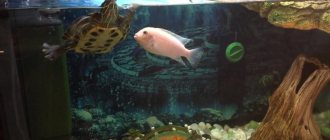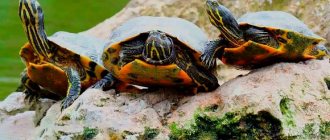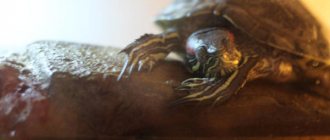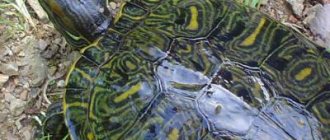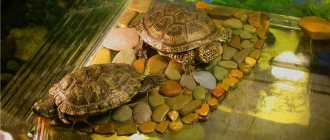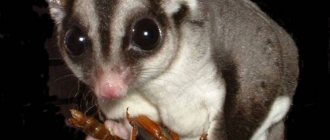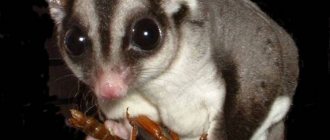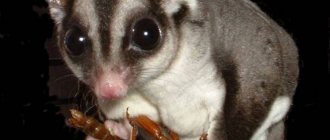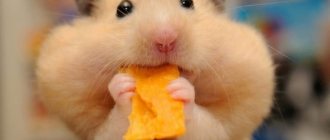It is necessary to feed a land turtle at home correctly; the diet must be complete and balanced. After all, high-quality food is the key to a long and healthy existence for a pet.
- 1 Food in natural habitat
- 2 Feeding characteristics of species 2.1 Omnivores
- 2.2 Herbivores
Food in natural habitat
In the wild, land turtles obtain their own food. This is, for the most part, plant food - grass, plant roots, berries, algae from the edges of reservoirs. Some part of the diet of wild turtles is protein food. These are worms, small insects, small snails.
The peculiarity of this reptile is that it can remain without food for quite a long time, storing significant reserves of it in its body during favorable seasons.
These animals are well versed in what vitamins, micro- and macroelements they lack at a certain stage of life and successfully find the products they need in the animal and plant world.
What should you not feed land turtles?
Unfortunately, the list of prohibited products is very extensive and you should familiarize yourself with it. This list includes cockroaches, crickets, eggshells, potatoes, garlic or onions, various meat products (including sausage and minced meat), bread, milk, various cereals (except rolled oats), citrus peels, cherries, seeds from any berries . These foods can cause liver disease, which will significantly shorten your life expectancy. Therefore, when starting to compile its diet, you should take into account the harmful effects of the above products on the turtle’s liver and not include them in the diet.
The full list of prohibited products can be found here.
Feeding features of the species
All natural species of turtles are divided according to their feeding method into three large orders:
- predatory;
- herbivores;
- omnivores.
Each of them has their own list of food products necessary for a full-fledged existence. But among the land species of turtles there are no predators, so it is important to consider only the diet of herbivores and omnivores. When purchasing these pets, it is imperative to find out what type of food they belong to.
The omnivorous species that are suitable for keeping at home and most often found in the world are the Mediterranean, musk, flat and Balkan.
Mediterranean Musk Balkan
Flat
Herbivores include star, Indian, Central Asian, Egyptian, serrated, red-headed, radiated, Galapagos.
Indian Star
Galapagos Radiant Redhead
Serrated
Egyptian
Central Asian
Omnivores
Their diet must necessarily consist of live food, for example:
- mice and small rats;
- frog;
- snails;
- insects - tubifex, bloodworms, daphnia, beetles, caterpillars, worms;
- slugs;
- fish and seafood.
The plant part of the diet should contain:
- vegetables;
- fruits;
- berries;
- aquatic plants;
- various herbs.
Herbivores
80% of the diet of these land turtles should be products of plant origin - various salads and spinach (leafy part), dandelion, cabbage.
Additional food:
- vegetable crops - pieces of carrots, cucumbers, zucchini, tomatoes, sweet peppers;
- fruits - apples, pears, peaches, apricots, bananas, citrus fruits;
- berries - cherries, raspberries, strawberries, grapes, currants, watermelon;
- other herbs - coltsfoot, sorrel, plantain, alfalfa, legumes;
- mushroom crops, such as champignons;
- special prepared food;
- bran and flakes from plant crops, sunflower seeds.
We recommend reading the article on what to feed pet turtles.
How to deal with dehydration
When turtles become dehydrated it can damage their kidney function quite dramatically and if this is the case then you need to seek veterinary advice as soon as possible. The correct treatment must be administered to ensure that the turtle rehydrates quickly and effectively.
Your veterinarian may advise force-feeding your pet, especially if dehydration has eventually led to anorexia, vision damage, or in cases where the sickly turtle will not or cannot feed itself. Luckily, turtles are quite easy to feed as they don't find it as distressing as other animals. This makes the procedure easier without the risk of harming the animal or yourself. There are three ways to force feed turtles which are listed below:
- Manual feed
- Syringe feeding
- Feeding the stomach
When it comes to hand feeding, this generally entails encouraging your turtle to eat as usual.
Syringe feeding, on the other hand, sees owners having to carefully syringe the selected food out of the turtle's throat. Finally, gastric feeding, where semi-liquid food is gently introduced directly into the animal's digestive system
This is done using a tube that is passed down the turtle's throat. However, this is a procedure that should be performed by a qualified veterinarian or veterinary nurse and should not be performed by anyone who does not know because if you get it wrong you could seriously harm your pet.
Home Diet Basics
At home, a land turtle does not have the opportunity to independently choose food, obtaining those products that its body needs at a particular moment. In addition, natural instincts are gradually dulled, which is manifested, for example, by the fact that it begins to absorb earth and small stones. Therefore, the owner of the reptile is responsible for the correct and balanced diet of the pet.
In order to prevent imbalances in nutrition, which can cause various diseases, it is recommended to keep a weekly diary of your pet’s nutrition. It creates a daily menu with the correct distribution of doses of vitamin supplements, calcium and amino acids.
The most correct diet would be the following ratio of products:
- herbs, greens - up to 75-80%;
- vegetable and fruit crops, berries - 10-15%;
- cereals, seeds, bread - up to 5%;
- vitamin supplements, micro- and macroelements, animal proteins, amino acids - up to 5%.
As herbs, the greatest preference should be given to the following plant crops:
- dandelion and lettuce (leaves);
- beans, peas, beans (stems and leaves);
- alfalfa;
- plantain;
- clover;
- parsley;
- aloe;
- lawn forbs;
- thistle;
- sorrel;
- sprouted wheat and oat sprouts;
- some flowering plants.
All types of land reptiles love vegetables:
- pumpkin pieces;
- fresh chopped carrots;
- small leaves of young cabbage;
- mature chopped zucchini, squash, cucumbers;
- radishes and beets - only in young fresh form.
It is advisable to give your pet pieces of apples or pears every day, and occasionally watermelon, strawberries, strawberries, raspberries, currants, peaches, and apricots.
All stone fruits are cored and the products themselves are cut or torn into small pieces.
As a protein component, you can give both worms, insects, snails, and small pieces of boiled or raw meat.
An approximate menu for the day might look like this (in grams):
- sprouted sprouts (for example, wheat) - 50;
- raw young beets, chopped - 30;
- chopped white cabbage leaves - 30;
- chopped boiled potato tubers - 30;
- raw minced beef or chicken or earthworms - 5-10;
- pieces of wheat bread - 25;
- fish oil, vitamins, microelements - 1-3.
It is necessary to give foods containing calcium a couple of times a week. For example, cottage cheese mixtures, cereal porridges - buckwheat, milk semolina or oatmeal.
At least once a week, the diet includes small quantities of seaweed, various bran, sunflower seeds, yeast, soybeans, mushrooms, and ready-made nutritional mixtures.
Would you like a drink, turtle?
Let your landlubber friend splash in the water sometimes.
Turtles of land species, as a rule, can obtain a sufficient amount of moisture from green and fruit and vegetable food. It is also known that these animals have the ability to absorb water through their skin. It is enough to satisfy the turtle's need for water during its 10-minute stay in the bathing suit.
You can ensure your pet is hydrated by bathing it daily. To do this, water is poured into the bath so that it covers only half of the turtle’s body. The head should remain above the water.
As for aquatic species, this is all a matter of course for them.
Like any living organism, turtles - whether a land herbivore or a freshwater carnivore - need a complete and balanced diet. A person who wants to have this reptile as a pet must approach this issue very responsibly.
Many people think that a turtle is an unpretentious animal; give it a cabbage leaf, and that’s enough. To avoid dramatic mistakes, you need to thoroughly familiarize yourself with the rules and diet of this reptile.
Do land turtles need water?
These reptiles, like other animals, require water for normal functioning. In nature, they get it from the stems and roots of plants, and also drink it when swimming in ponds.
There is no need to install special drinking bowls for a domestic reptile, but regular bathing should be organized. For some species, weekly water procedures are needed, for others it is enough to carry them out once a month. But it is still optimal to bathe pets once a week, and even more often in the hot season.
It is enough to pour warm water into a small container, not lower than +25 °C, and lower the pet there so that the liquid covers the entire upper shell and reaches at least the middle of the neck.
Why doesn't the turtle eat anything?
- frequent feeding;
- the turtle fell into hibernation;
- mating season;
- diseases.
Well, now about everything in more detail.
Frequent feeding
Excessive care, expressed in frequent feedings, also leads to negative results. Before feeding an animal, you need to familiarize yourself with its nutrition, which directly depends on its age.
If the turtle has stopped eating, then the first thing you should pay attention to is the frequency of food intake. For an adult, one meal every few days is enough, and daily feeding can lead to this result.
Under no circumstances should you force feed a turtle. If she refuses to eat, it means she has enough energy reserves. Therefore, you need to control the frequency of your turtle's food intake.
Not knowing the intricacies of keeping turtles, many owners ask the same question regarding how much water a turtle should drink and how often it should be watered. Most turtles do not need this, but your turtle will need to be bathed more often. It is at this moment that the turtle will stock up on the necessary moisture. The turtle is not in danger of dehydration, since the food contains a certain percentage of moisture; by observing the reptile, you can determine whether it needs moisture. If a turtle prefers succulent food, it means that it really needs it.
Hibernation
Before this, the reptile begins to lead a semi-active lifestyle. If she is not active and refuses to eat, it is quite possible that she needs to find a suitable place with suitable conditions for hibernation. Since it will not be possible to provide it with appropriate conditions, it is better to increase the temperature of its contents with an increase in the amount of light. An increase in its activity will certainly indicate precisely this reason. This fact will indicate that the turtle could have been kept under proper temperature conditions.
Breeding period
If two individuals of different sexes grow in an aquaterrarium, then the result can be absolutely predictable, especially since mating games are hard to miss. Naturally, during this period they have no time for food, and after that they will definitely eat more than they need. Therefore, there is no reason to worry.
Diseases
This is the worst thing that can happen. Any disease depresses the animal, and as a result, it may refuse to eat. If it is discovered that the turtle has become lethargic and has stopped eating, it is imperative to inspect it. This examination may help detect certain diseases. If nothing is visible visually or there is no such experience, then it is better to contact a veterinarian. Only a professional can determine the cause of a turtle's poor appetite and lethargy. If a cause is found, appropriate medications will be prescribed and appropriate therapeutic procedures will be carried out. Moreover, the veterinarian will be able to give useful advice based on identifying the cause. The fact is that many turtle owners do not particularly delve into the intricacies of their maintenance, as a result of which they have many questions. Such a visit to the veterinarian will always be useful.
It is better not to resort to self-treatment or diagnosis. As a rule, this leads to a deterioration in the pet’s condition and serious harm to its health. After such individual treatment, very often, even the veterinarian is unable to do anything.
If it is not possible to visit a veterinarian, then you need to examine her very carefully and analyze her living conditions and diet. Without a reason, just like that, a turtle will not get sick. Either she has poor nutrition, or she is kept in unsanitary conditions, or the temperature regime is far from optimal. Of course, you can change everything, but not always. In this case, you cannot do without a visit to a specialist. So that you don’t have to look for a veterinarian for your pet, you don’t need to forget about him and constantly look after him, providing him with acceptable living conditions that are close to natural ones.
Food in summer and winter
Summer feeding of land turtles is usually not difficult, because fresh herbs, vegetables, fruits, and berries can be easily picked or purchased.
Food should be prepared for the winter. Greens can be cut and frozen in the refrigerator, dividing them into daily portions. You can do the same with fruits and vegetables. Forbs can also be prepared in the form of hay.
If there are fish in the house, then you can plant an abundance of aquatic plants in the aquarium and feed your land pet with them in winter.
In the terrarium you can also install clay pots in which alfalfa, oats, wheat stalks, plantain, dandelion sprouts, and cultivated varieties of greens grow. All types of land turtles happily eat sprouted carrot tops.
How much and how often should you feed your red-eared slider?
It is difficult to answer both of these questions unequivocally: it all depends on the size of the pet, age, and also the food that the reptile eats. First, let's look at young turtles, that is, up to a year old. They should be fed with store-bought food every day. However, it is also necessary to provide plant foods: vegetables, herbs, fruits, even if the pet refuses at first.
It’s worth trying to feed the turtle bloodworms; you can start introducing aquatic crustaceans into the diet. The amount of food for young turtles also differs from the amount for older representatives of this species. They should get about fifty percent (50%) protein in their food daily. Therefore, feeding artificial food alone will not be enough.
To cover such a nutritional deficiency, the owner of a reptile needs to add turtles to the menu - fish like guuppies, and, if possible, earthworms and insects. Some experts claim that even at such a young age, your pet can happily eat boiled meat or minced meat. However, this food should be introduced into the diet gradually.
Since food varies, you need to carefully select the brand that is specifically designed for your pet. Namely: according to his age and size
It is important to know that young representatives of this type of reptile need additional feeding with vitamins; it is worth consulting with the breeder or veterinarian about this.
Only with proper feeding will red-eared turtles be able to grow and develop normally.
For adult red-eared turtles (more than a year old), the percentage of artificial food in the diet should be no less than ten (10%) and no more than twenty-five (25%).
It is worth gradually adding plant food (for turtles older than a year, these are lettuce leaves, dandelion leaves, cabbage and slices of fresh cucumber). All this must be given, even if the pet refuses at first. You can and even should give your turtle boiled or raw chicken or beef.
Some experts suggest giving the red-eared turtle raw meat of lean fish, but pre-cooked (about a minute) in boiling water. Small aquarium fish can be given both in crushed form and live, but it is worth weighing the size of the live bait with the size of the turtle.
A reptile that is between one and two years old should be fed every other day. And an older pet, starting from the age of two, needs to be fed once every two or even three days. But this, again, also depends on the individual characteristics of the reptile.
The turtle, which has reached three years of age, begins to feed more and more on algae. To make the aquarium look aesthetically pleasing, aquatic plants should be grown in a place separate from the reptile.
It is important not to overfeed your pet, but at the same time not to leave it without the vitamins it needs. Any food for reptiles must be of high quality and fresh.
Frozen food should first be thawed and warmed to room temperature.
Food for turtles of all ages should be thrown directly into the water, but it is important to correctly calculate the amount of food, otherwise uneaten food will rot in the water, after which it will need to be changed. You should feed your reptile during daylight hours, as they are active during the day.
With the correct calculation of the age, size, characteristics of the red-eared turtle and selection of food, the owner will have a healthy and happy pet
You should feed your reptile during daylight hours, as they are active during the day. With the correct calculation of the age, size, characteristics of the red-eared turtle and selection of food, the owner will have a healthy and happy pet.
Mr. Tail explains: foods prohibited for land turtles
The owner of these reptiles should be well aware of the foods that should never be given to pets:
- stone fruit seeds - apricots, peaches;
- citrus peel;
- plants that are poisonous and medicinal, such as buttercup, nightshade, potato and tomato tops, crocus, narcissus, milkweed, delphinium, hydrangea, mistletoe, dieffenbachia, azaleas, lilies, elodea;
- sausages and canned goods.
Porridge, baked goods, dairy products, eggs and eggshells, meat, onions, garlic, celery, spinach stems, radishes, and spicy herbs are allowed only in minimal quantities.
The dangers of overfeeding and underfeeding
Overfeeding a red-eared turtle can cause:
- abnormal growth of young individuals, in which case they have a disproportionately large shell and fragile, small paws;
- obesity in adult reptiles, you can see fat on their sides when they pull their paws into the shell, skin folds that look like bubbles are visible;
- the pyramidality of the shell, in which tubercles can be seen on it; this pathology provokes various diseases of the internal organs of the turtle;
- tympany, in which the reptile does not sink in the water and falls on its right side, undigested food is visible in the feces, it can blow bubbles from its mouth, and vomiting is possible.
Lack of food will lead to exhaustion of the pet, in which skin peels off from the reptile's paws.
This is why it is so important to know how much and how often to feed red-eared turtles.
Feeding rules
It is advisable to eat at the same time every day, preferably in the morning.
When feeding turtles, you must follow simple rules:
- Up to a year of age they are fed every day, after two years they can be fed every other day.
- Food utensils should always be washed clean before each feeding.
- Portions should be made small, and excess should be removed from the terrarium so that it does not spoil.
- Try to ensure complete rest for your pet while feeding. The turtle is frightened by loud sounds and sudden movements.
- Reptiles should not be taught to eat from their hands. They very quickly get used to this method of feeding, and then refuse to eat from the bowl.
- You should not overfeed your pets, that is, give food too often, this can lead to obesity and distortion of the carapace and plastron.
- Feeding too infrequently is also unacceptable, as this can cause exhaustion and death.
How long can a turtle go without food?
Adults, if they are healthy, can go without eating for 2 weeks without harm to their body, young reptiles - up to a week. When the pet is too small, it can live 3-7 days without food.
Therefore, if the owners have to leave, then you can leave the adult turtle alone for 7-10 days without anything happening to it. However, it is advisable to introduce small fish, snails and algae into the terrarium; if the reptile gets hungry, it can eat them.
A turtle may not eat for several reasons:
- because of the cold;
- due to stress;
- during the breeding season, if the terrarium contains different-sex individuals, then they do not eat during mating games, but after they are over, the appetite will return to the reptiles;
- due to the transition of the pet to an adult diet too early, small turtles should not be given fish and boiled eggs;
- because of illness.
When you just got a reptile, it needs some time to get used to the change in environment. If the turtle refuses food for more than 3 days, but is still mobile and has no visible signs of illness, then perhaps you are not caring for it correctly.
When the pet is passive, there is nasal discharge, sneezing, swollen eyes, the turtle is blowing bubbles, then it should be shown to a specialist.
It is important not to overfeed the red-eared turtle, but you should not starve it either. The food should be thrown directly into the water, but at the same time make sure that the leftover food does not begin to rot in the terrarium
To avoid this, you can place your pet in a separate container with water during feeding, and then return it back to the terrarium.
The turtle needs love too
It is very important to understand that a turtle is a living creature that requires care and attention, and not a toy that can be played with and left to the mercy of fate. If you have chosen these unique reptiles, take a responsible approach to the question of what to feed your turtle at home.
After all, the health and life of your pet depends on it. The more seriously you take the conditions of its existence, the longer the turtle will be able to please you. When buying a turtle, contact experienced sellers who can tell you what to feed a water turtle at home and what to feed a land turtle, so that later you don’t have to guess why your pet died, because you fed it.
It turns out that if a turtle is not fed correctly, it begins to be capricious, eat poorly, or even refuse food altogether. or steppe turtles are no exception. In order for your pet to feel at ease, properly structure your baby’s diet.
What to feed the Central Asian land turtle?
Let's start with the fact that absolutely all turtles love plant foods. Healthy plants include cabbage, pumpkin, watermelon, melon, lettuce, apples and dandelions. They will not refuse berries - raspberries, cherries and strawberries. Milk with white bread soaked in it will also appeal to the armored animal.
Don't think that turtles are vegetarians. They eat absolutely everything. Therefore, you need to be very careful when decorating terrariums. After all, almost everything that gets there will be “tested.” So, do not deprive your pet of protein food. One tablespoon of raw minced meat or half a hard-boiled egg is enough. But instead of feeding a domestic land turtle with meat that is harmful to it, make up for the lack of protein by replacing the product that is bad for the kidneys with a real worm, which is fed to aquarium fish. But don't overdo it. Any food of animal origin can lead to indigestion. It’s better to replenish your turtle’s kitchen with beans rich in vegetable protein.
Do not overfill your turtle's diet with tomatoes, cucumbers and carrots. They don't like them. This is easily explained, because in the wild these animals eat berries, desert plants or carrion.
What to feed a land turtle in winter?
Turtles usually hibernate during the winter. But the house is quite warm during this cold period. Therefore, the turtle does not sleep, but simply becomes slow. What should you feed your land turtle at home during this period?
Food products can be left the same. But don't be surprised if your little friend can't make it through the summer daily quota. An approximate daily diet can be calculated for the winter period, and it will look something like this:
Just don’t forget to enrich this list with herbs in the summer, for example, dandelion, the leaves of which can be picked far from a busy and polluted highway and city.
Does a land turtle need to be given water?
We told you what to feed domestic land turtles. But, after all, they also need water, although they drink quite rarely: some drink it once every one to two weeks, while for others, one “date” with water per month is enough. The frequency with which water treatments need to be administered depends on what the animal eats over a certain period of time. If it is cabbage, then the cells of the turtle’s body receive a sufficient amount of moisture, and you will have to “bathe” less often. But if the majority of the daily diet consists of white bread, baths should be arranged a little more often.
Although, in order not to rack your brains, give your turtle a bath day once a week or a week and a half. Pour a little less than a centimeter of water into the basin. The pet's nose must be above the water level so that the land inhabitant of our planet does not suffocate. Place the animal in the water and leave it to enjoy for half an hour. Believe me, this time is enough for the baby to have time to get drunk and take a swim.
Unfortunately, many people do not take turtles seriously enough, not like other pets, they know little about the peculiarities of keeping and caring for them, and most importantly, they have little interest in the question of what to feed turtles. But these babies also require a balanced diet, various nutritional supplements for active growth and well-being.
Habitat arrangement
The reptile takes a long time to get used to new environmental conditions. To make the adaptation process easier for her, think in advance and buy everything you need to keep and care for your turtle at home.
You will need:
- Container - terrarium or aquarium.
- A small house where the animal will sleep and hide.
- Heating lamp.
- UV lamp.
- Containers for food and water.
- Thermometer.
- Substrate.
- Caches.
A waterfowl reptile needs a separate aquaterrarium with a capacity of about 100 liters. Water should take up most of it. Red-eared turtles require a space of more than 200 liters.
Additionally, a filter is installed. Turtles excrete a lot of waste products, and unfiltered water will be very dirty. Change at least 20% of the fluid every week.
Tap water is purified from chlorine and heavy metals before use. Add special conditioners to the terrarium liquid - they will neutralize turtle feces.
Use a heater to maintain the water temperature at 25-28 ºС. If it is cold, the animal will become lethargic, its metabolic processes will slow down, and there will be problems with digestion.
This condition is unacceptable - it leads to the death of the turtle. To maintain the desired temperature, install a thermostat in the terrarium.
Equip a separate area of land with a bridge where the animal can get out of the water. The island should be comfortable and smooth. Place a UV lamp on it.
Ultraviolet light promotes the release of vitamin D, without which calcium cannot be absorbed. A deficiency of this element leads to rickets, a fragile shell.
The temperature of the island of land should be 30-32 ºС. Turn off the UV lamp and heating at night.
Place stones the size of the turtle's head or larger at the bottom of the terrarium so that it cannot swallow them. Decorate your reptile's home with artificial plants - the living ones will be eaten. Use primer solely for aesthetics.
If you have a land turtle, it is advisable to choose glass housing for it. But a wooden box will also work if one side is transparent. The conditions in it - filling, lighting, additional elements - should be close to the natural environment.
Make sure there is good ventilation. The holes should be located at different levels on opposite sides of the terrarium.
Cover the bottom of your pet's home with hay. It is easy to change, it is comfortable to lie on, and the animal will not be able to swallow straws, which cannot be said about sand or small pebbles.
You can only use large pebbles on which the turtle will sharpen its claws. Corn mulch or cellulose filler is also used as bedding. They are easy to clean and a turtle can happily burrow into them.
Build a sleeping place from a plastic flower pot cut in half or use a wooden house for rodents.
Securely secure the feeder and water bowl. The turtle should not turn over “kitchen utensils” while walking around the terrarium.
Buy a mineral stone: the animal will chew on it and get extra calcium, and also sharpen the rhamphotec (beak). Install a heating lamp near the feeder and drinker; do not allow the air temperature to drop below 30ºC.
An ultraviolet lamp will imitate the sun's rays. The required power of the device is 10-12% UVB (UVB 200).
It's also worth knowing that reptiles transmit serious diseases, such as salmonella. Wash your hands thoroughly after direct contact with an animal.
How long does a marsh turtle live?
Proper care will allow a turtle to live in captivity for up to 30-50 years, and, according to some scientists, a turtle can outlive a person.
Reptile breeding
In the spring, the breeding season begins in the natural environment. Males and females over 6 years old, whose shell reaches more than 9 cm, are able to move far from a river or swamp, but the act of mating, one way or another, occurs near water. What’s surprising is this: the inseminating liquid is stored in the reptile’s body for a whole year or more, which often leads to “unexpected” laying of eggs after several months of the petiole being at home with the new owner.
Egg laying usually occurs from late spring to mid-summer. Three times, turtles lay eggs in holes dug in the ground, at a depth of up to 10 cm. The eggs look like this: the shell is white, oblong, weight up to 8 g. From 8-19 eggs, small turtles will hatch in 2-3 months.
If you are breeding pets at home and want to influence the sex of a marsh turtle, carefully monitor the temperature throughout the incubation period. When the thermometer is below 27 degrees, male turtles are born; at 30 degrees or more, female turtles are born. In intermediate indicators, it is possible to obtain cubs of both sexes.
So, you have learned how to care for a swamp turtle if you become its owner, what to feed it and how often to do it, how to create a comfortable environment and breed reptiles, what ways to protect yourself from aggression and how to take care of your pet’s health. The better you take care of your girlfriend, the longer and better her life will be. If you are not sure that you are able to strictly follow all the advice, simply do not get such an unusual and capricious pet. And if you have already decided, then be responsible.
Three groups of turtles
Based on their feeding type, turtles are divided into three groups: carnivores, omnivores and herbivores.
. Each of them corresponds to a certain ratio of animal and plant foods. Feeding inappropriate food for each group of turtles is fraught with diseases of the internal organs, digestive complications, and metabolic problems. You also need to include calcium and vitamins in your diet weekly. What food should be given to each group?
Predatory
The food of predatory turtles should consist of 80% animal food and 20% plant food. This group includes almost all aquatic species and all young aquatic ones, such as young red-eared, caiman, trionics, swamp, musky, etc.
The main food for them is:
The turtle can eat all seafood, as well as fish, only raw; heat-treated food should not be given;
Additional food
, which should be given once a week, serves:
It is prohibited to give to predatory turtles:
meat (beef, chicken, pork, lamb, sausages, sausage, any type of minced meat, etc.), as well as fatty fish, milk, cheese, bread, fruit, dog or cat food, etc.
The diet of this group of turtles should consist of 50 percent animal food
and 50 – vegetable. Omnivorous turtles include semi-aquatic and adult aquatic turtles, some types of land turtles: spiny turtles, coora turtles, adult red-eared turtles, Spengler's turtles, red-footed turtles (coal turtles), etc.
Their menu consists of half animal food, see the list above, and half plant food, the list is below. Aquatic turtles are pampered with fish
and seafood (as animal food), and mice are given to land animals.
Herbivores
The menu of this group of turtles is based on plant foods, which make up 95% of the total diet, animal food consists of 5%.
Herbivores include: all land turtles, including radiated, flat, Central Asian, Greek, spider and others.
The main food of this group is:
Additional food
once a week, it includes:
It is prohibited to give meat; this category includes: any minced meat, sausages, sausage, chicken, beef, pork, etc.). Also fish, milk, cheese, cat or dog food, bread...
What to pay attention to when feeding a turtle?
It is very important to understand that a turtle is a living creature that requires care and attention, and not a toy that can be played with and left to the mercy of fate. If you have chosen these unique reptiles, take a responsible approach to the question of what to feed your turtle at home.
After all, the health and life of your pet depends on it. The more seriously you take the conditions of its existence, the longer the turtle will be able to please you. When buying a turtle, contact experienced sellers who can tell you what to feed a water turtle at home and what to feed a land turtle, so that later you don’t have to guess why your pet died, because you fed it.
It turns out that if a turtle is not fed correctly, it begins to be capricious, eat poorly, or even refuse food altogether. or steppe turtles are no exception. In order for your pet to feel at ease, properly structure your baby’s diet.
Terrarium and its arrangement
To keep a land turtle you need to purchase a terrarium. For a number of reasons, you should never leave a turtle to live on the floor. A pet can catch a cold due to drafts “walking” across the floor, it can get stuck and get damaged, and dust that clogs the airways also negatively affects its health.
Land turtles love to burrow and hide in secluded places. You may not notice and accidentally step on a turtle. In the best case, it will receive damage of varying severity; in the worst case, it can be crushed.
- The minimum size of the terrarium is 80x50x40 cm.
- The bottom of the terrarium must be covered with soil 10-15 cm thick.
- Inside the terrarium you need to install a heating lamp and a UV lamp.
- Be sure to put up a house, which is needed as a shelter.
Many owners do not consider it necessary to install a UV lamp, which is why turtles often suffer from rickets. The UV lamp helps produce vitamin D, which makes calcium better absorbed in the body.
Walks
In the summer, the turtle must be walked. To prevent the turtle from running away and getting lost, it is necessary to build an enclosure or fence for it. It is very important to deepen the fence a few centimeters into the ground, since turtles like to burrow into the grass or soil.
Despite the slowness of the land turtle, it is easy to overlook and get lost in the grass. Therefore, you should keep an eye on her while walking.
Do not leave your turtle in direct sunlight. She must have a dark or secluded place where she can hide.
Description of the marsh turtle
If we were painting a portrait of a marsh turtle, then its most important detail would look like this: an almost oval carapace of small height (about the term - help below), in which the width of the rear part is clearly greater than the front. In the largest individuals, the length of the carapace reaches 20 centimeters or more.
The carapace is the convex dorsal shield of a turtle's shell, consisting of a bone base and a horny covering.
Due to the fact that these turtles mainly live in the water element, the carapace of the animal is tightly pressed to each other, and it itself is streamlined in shape, without any protrusions, the fingers are connected by membranes. The turtle's paws have large and sharp claws, which is logical, since it is a predator. With their help, the turtle is able to tear its prey apart (your hand will not be the object of the hunt, but you should not let your guard down when communicating with your pet).
The tail of this reptile is quite long (up to 12 cm, which is often ¾ of the entire length of the shell). Its main function in the water is to guide and assist in maneuvering, creating a counterweight and maintaining balance during sharp turns. Moreover, in females it is shorter than in males.
The average weight of a reptile is 1.5 kg.
As for the color scheme, the swamp pet’s carapace is usually dark (from olive and khaki to almost black), but the plastron is light (closer to yellow). The body is densely covered with small light splashes and spots. The eyes depend on the gender: in males they are most often red, and in females they are light shades.
Habitat
The known European marsh turtles can be seen in large numbers in Europe, Asia or Africa. Their habitats are bodies of water (from swamps to streams, rivers and ordinary puddles somewhere in the forest). Water is an absolute comfort for them, but they also love to bask in the sun, and to do this they have to crawl onto the shore or rocks protruding upward. These creatures try to catch the sun's rays even on the coolest and gloomiest days. But as soon as the turtle hears an extraneous sound, it will immediately run into shelter (water) from the unpleasant attention. Strong paws allow the swamp beauty to swim quickly, and its claws allow it to instantly bury itself in the mud or under foliage near the shore.
With the arrival of cold weather, in mid-autumn, picky animals hibernate: this is how they escape the winter cold. With the warmth of spring, they wake up again.
Stop feeding the turtle!
Stop treating the beast like a hothouse baby that can go hungry in a few days. A turtle (for example, Central Asian) is a wild desert reptile! In terrarium conditions, it will most likely disappear from overfeeding, but not from starvation.
The shell and bones of a turtle normally grow slower than the “rest” of the body, and a fairly moderate and specific diet is needed to maintain proper shape. But what do people often do out of ignorance? Instead of tough leaves and flowers rich in fiber for normal digestion (tonins and alkaloids, so that parasites do not breed), which turtles receive in nature, they are given juicy salads, vegetables, and even fruits.

